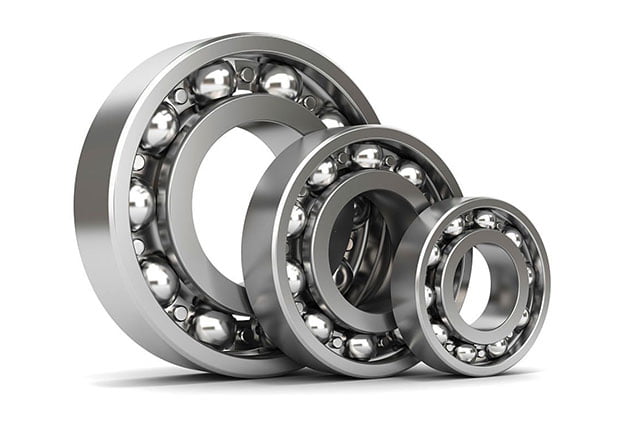Bearings. An everyday phenomenon that, like so many others, goes unnoticed. You’ve probably heard of them, but did you know that without bearings, many of the conveniences of modern life would not be possible? To fully appreciate the immense value that bearings contribute to our daily existence, let’s begin with a simple definition.
A bearing is a machine element that constrains relative motion to only the desired motion and reduces friction between moving parts. The design of the bearing may provide for free linear movement of the moving part, free rotation around a fixed axis, or limited movement to prevent undesired motion.
So where do we find these bearings, and how do they help our world turn? Let’s dive into it and learn more.

Table of Contents
The World On Wheels
Perhaps the most relatable and ubiquitous application of bearings is found in the realm of transportation. From the skateboard of an enthusiastic teenager perfecting his ollies and kickflips, to the family sedan embarking on a weekend road trip, or the mammoth-sized industrial freight truck shipping goods across the country, vehicles of all sizes and types rely on the humble bearing. Why is this?
Bearings play an integral role in wheel assemblies, reducing friction and supporting loads to ensure that wheels can spin freely. Their work significantly contributes to the vehicle’s overall energy efficiency and the comfort of the ride. Without them, the wheels on our cars, bicycles, skateboards, and even aircraft, would not turn nearly as smoothly, and the effort required to move these vehicles would increase dramatically.
The Machines That Make Machines
Stepping inside a bustling factory, you’ll find another world where bearings hold sway. Robotic arms assembling everything from cars to smartphones, conveyer belts tirelessly moving parts, materials and finished goods from one end of the plant to the other, or the electric motors that power these machinations, all depend on bearings to function optimally.
Bearings allow these machines to work at high speeds with remarkable precision. They enable them to withstand the intense pressures of a 24/7 production cycle, significantly reducing downtime due to maintenance or repair. In a sense, bearings are the unsung heroes that keep our industrial gears turning, facilitating the production of goods we use daily.
The Home That Bearings Built
Turning to our home environments, the quiet yet omnipresent influence of bearings becomes even more apparent. From the hum of your refrigerator preserving your food, the whirring of your vacuum cleaner keeping your floors clean, or the rhythmic churn of your washing machine tackling the week’s laundry, you are experiencing the magic of appliances made efficient by bearings.
Furthermore, think about your home’s HVAC system, which works hard to keep you comfortable in all seasons. Bearings enable the fans in these systems to circulate warm and cold air efficiently throughout your home. They significantly contribute to the quiet operation of these systems, ensuring that they do their work in the background, practically unnoticed.
A Digital Life Powered by Bearings
In today’s digitally dominated age, our lifestyles heavily depend on our laptops, smartphones, and tablets. But did you know that these devices owe their functionality, in part, to bearings? Within the hard drives of our computers, tiny, precision bearings ensure that the disks spin smoothly and accurately. This spinning motion allows us to access our stored data efficiently, enabling us to work, learn, and entertain ourselves digitally.
Bearings in our digital devices must be incredibly precise and reliable because a tiny fault can lead to significant data loss or hardware damage. Without these minuscule, yet essential elements, our digital life would undoubtedly come to a grinding halt.
Bearings in the Green Energy Revolution
As we collectively make strides towards a greener, more sustainable future, bearings are playing a pivotal role. Take wind turbines, for instance, a symbol of renewable energy. These gigantic structures depend heavily on robust and efficient bearings. The bearings used in wind turbines must be highly durable, capable of enduring harsh weather conditions and the massive mechanical loads exerted by the spinning blades.
Bearings help convert the kinetic energy of wind into electrical power with minimal energy loss. They play a crucial role in ensuring the turbines’ longevity and effectiveness. Without the presence of these hardworking bearings, the promise of a greener and more sustainable future would be considerably more challenging to fulfill.
Keeping Time with Bearings
Bearings also have a vital role in horology, the art and science of timekeeping. From delicate pocket watches to grand tower clocks, bearings are crucial for the accurate and smooth movement of the watch hands. In high-precision timepieces, jewel bearings made from synthetic sapphire or ruby are used to minimize friction and wear.
These jewel bearings underscore the extraordinary diversity of materials and sizes that bearings can take on, adapting to the unique demands of various applications. Without bearings, the accurate timekeeping we often take for granted would be significantly more difficult to achieve.
To recapitulate, bearings, though modest in size and often overlooked, hold an incontestably paramount role in setting the rhythm of our modern world. Their presence and function may be cloaked by the larger, more visible machinery they support, but their significance can’t be overstated. These tiny mechanical marvels diligently work behind the scenes, managing friction, amplifying efficiency, and facilitating the seamless operation of an astounding array of machines and devices that weave the complex tapestry of our day-to-day existence.
Consider for a moment the seemingly endless journey of bearings from the wheels that transport us. Every skateboard trick landed, every family car journey embarked upon, every commercial airplane taking to the skies – each one of these experiences is enabled by bearings. They bring motion to our world, allowing us to move freely, efficiently, and comfortably.
Then there are the industrial hubs, the factories that build our material world, from our cars and home appliances to our digital devices. Bearings form the cornerstone of these production lines, allowing them to operate at high speed and with incredible precision, tirelessly creating the goods that make our lives easier, more productive, and more enjoyable.





